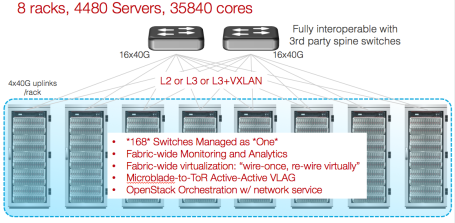Netvisor powers the Rackscale Architecture from Intel/Supermicro
May 6, 2014 at 9:41 am Leave a comment
On May 5th, 2014, we announced that Pluribus Networks Netvisor is now powering the switch blades on the new Intel blade chassis announced by Supermicro Inc. Its creating quite a stir and is a proud moment for everyone at Pluribus Networks and Supermicro who made this possible.
There are several reasons why Netvisor is the ideal Hypervisor to power the switching blades:
- Integrated Openstack Controller with Horizon and REST APIs as the only management that is needed – The entire Netvisor cluster-fabric and the virtual/physical switching on the compute blades is exported to Openstack via neutron plugins and extensions. Our Freedom series Server-Switches also bundle the full Openstack controller allowing the entire rack of microblades to be managed as one unit via Openstack Horizon GUI. For people wanting to manage the network layer via traditional tools, Netvisor also offers a full featured cli to manage teh cluster-fabric along with high performance and multithreaded native C and Java APIs. Netvisor also provides multiple virtualized services with H/W offload. So services like NAT, DNS/DHCP, IP-Pools, Routing, Load balancing, etc are integrated via Openstack Horizon to support multi-tenancy at scale.
- Netvisor is a Distributed Plug and Play Hypervisor – The Supermicro blade chassis has 4 switch blades and 14 server blades. This is where the racks are going with micro servers etc. In a typical rack, you will have 7 such chassis giving you 98 server blades and 28 switch blades plus two top of the rack switches. An ideal platform for Rackscale computing that HPC and Private Cloud needs. In such architecture, you can’t deal with individual switches. Netvisor provides a full plug-and-play architecture with zero touch provisioning and entire switching infrastructure appears as one cluster-fabric with synchronized state and configuration sharing with no cabling mess. The entire cluster-fabric protocol and algorithm is based on TCP/IP with no special ASIC and H/W.
- Application level Analytics and Debuggability – Netvisor has in built support for looking at all physical servers, virtual machines and applications without needing any probes or agent software. The addition of Freedom series as Top of the Rack layer allows users to track millions or VMs and application level flows in real time as well as historical data. Helps with capacity planning, audit, congestion analytics, VM life cycle management, application level performance and debuggability analysis. In multi-tenancy enviroments, Netvisor allows each individual tenant to analyze its own VM, applications, and Services.
- Netvisor powers all types of switching platforms – Just the way server Hypervisor are now ubiquitously running from laptops to desktops to high end servers, Netvisor also supports Micro switch blades to the ODM Top of the Rack switches and more powerful Server-Switches.
- Netvisor runs on every possible control plane – On the Supermicro switch blades, Netvisor runs on a Avaton based control processor with 8Gb of memory and limited Flash storage. On other switches, it uses single to dual socket Xeon with 512Gb RAM and Fusion-io based storage.
- Netvisor is full Open – It runs on all open platforms is built from best of the breed Open source OS with addition for switching, Cluster-Fabric, and switch Virtualization. Run it as traditional switch mode or with your users choice of Linux (Ubuntu and Fedora by default).
Use Netvisor with Openstack on Supermicro’s blade chassis along with the Freedom series Top of the Rack to run the most dense and power efficient Rackscale Architecture today.
Entry filed under: Netvisor. Tags: Alta, centralized controller, Crossbow, Hypervisor, Integrated Openstack, Netvisor, Network OS, openstack, Pluribus Networks Netvisor, Supermicro, Supermicro Inc., switch blades, Virtual Switch, whitebox switch.

Trackback this post | Subscribe to the comments via RSS Feed